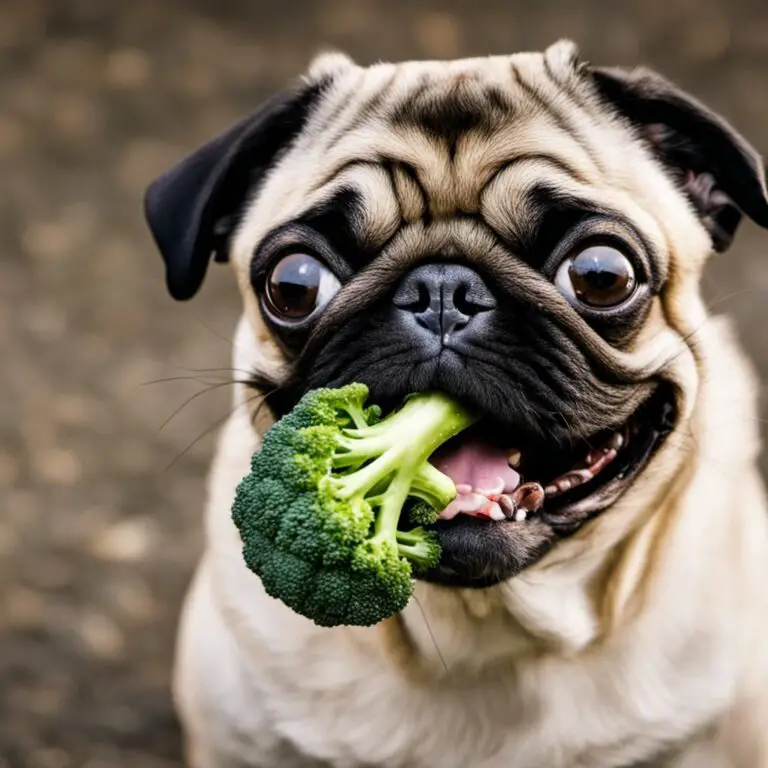Can Pugs Eat Dragon Fruit? Decoding the Myth
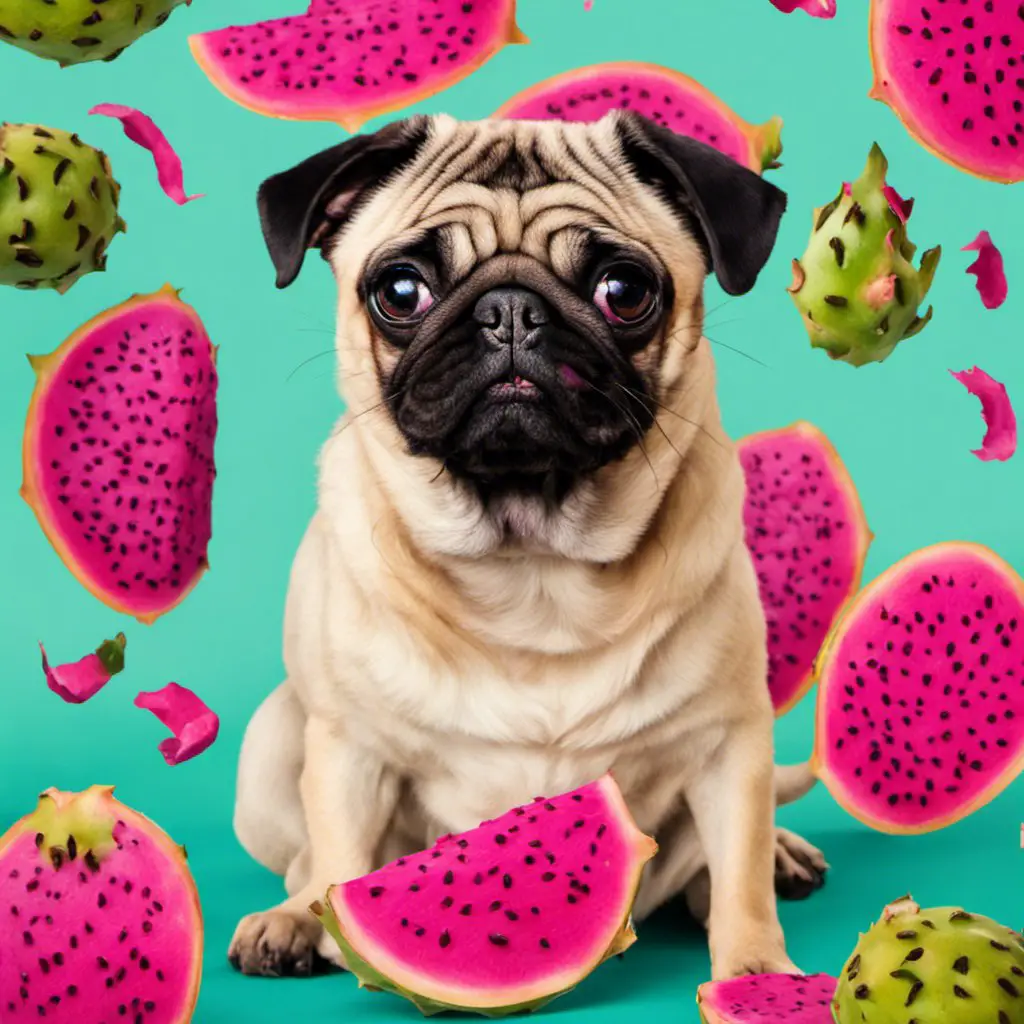
Dragon fruit, also known as pitaya, is a delicious and exotic fruit that has gained popularity due to its unique flavor and potential health benefits. Dog owners often wonder if they can share this nutritious fruit with their four-legged friends. In this article, Can Pugs Eat Dragon Fruit? We will explore whether pugs can safely consume dragon fruit, along with important preparation steps and potential benefits for their overall health.
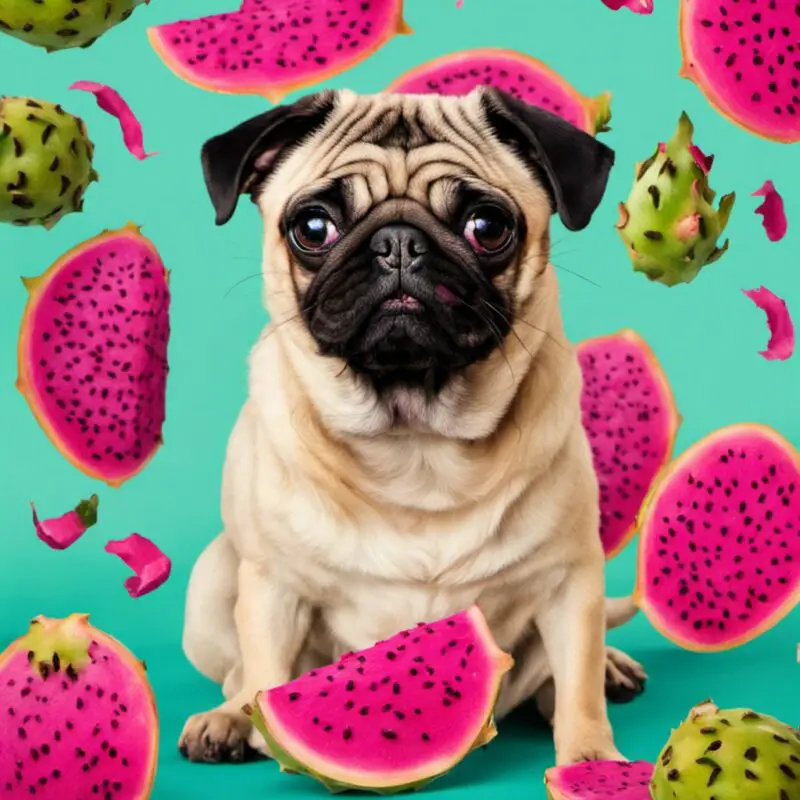
Though many fruits are considered safe and healthy snacks for dogs, it is crucial to know which ones to avoid, as some can be toxic or harmful to their digestive systems. Fortunately, dragon fruit has been found to be non-toxic to dogs and can make a healthy treat due to its high levels of antioxidants and prebiotics.
Before sharing dragon fruit with your pug, it is essential to properly prepare the fruit by removing the skin. Your pug can benefit from the occasional addition of dragon fruit to its diet as long as it is offered in moderation. In the following sections, we will dive deeper into the nutritional aspects of dragon fruit and discuss how it can contribute to your pug’s overall well-being.
Contents
Table of Contents
An Overview of Dragon Fruit
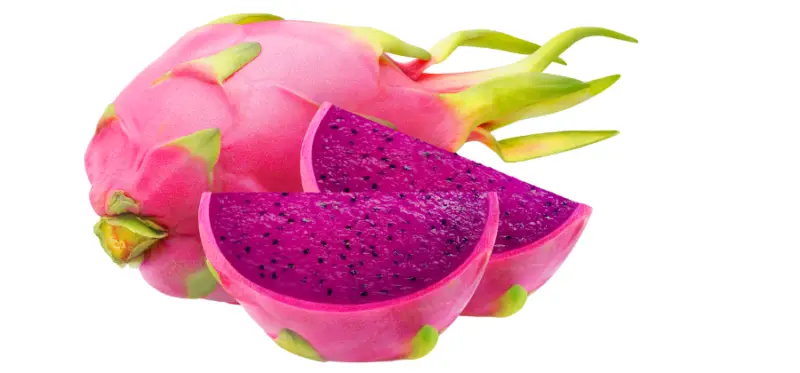
Dragon fruit, also known as pitaya, is a tropical fruit that offers a unique blend of flavors reminiscent of tropical and citrus fruits. It’s typically available in various colors, such as pink, red, yellow, and purple, offering a wide array of visual appeal.
Get The Free Food Eating Guide That Keeps My Pug Happy and Playful Even at 13 Years Old
100% Beginner Friendly & Lists Real Foods Your Pug Can Actually Eat!

The attractive fruit has an outer layer of skin that is rugged and vibrant, while inside, the flesh of the dragon fruit can be white or red with many small black seeds scattered throughout. The taste of the fruit’s flesh can range from mildly sweet to tart, depending on its ripeness and variety.
Dragon fruit can be found in grocery stores and local markets, often in the form of fresh whole fruits, but it can also be found frozen when it’s out of season. The fruit is highly versatile and can be enjoyed in various ways, such as salads, smoothies, or on its own as a healthy snack.
When consuming or serving dragon fruit, removing its tough outer skin and consuming only the tender flesh inside is essential. You can scoop out the flesh with a spoon, cut the fruit into segments, and then remove the skin with a knife. Once the outer layer is removed, the fruit can easily be incorporated into a variety of dishes or consumed on its own.
In summary, dragon fruit is a visually appealing tropical fruit that comes in various colors and offers a unique flavor. Enjoyed fresh or frozen, this versatile fruit can be a delightful addition to your diet and a tasty treat for both people and their canine companions.
Understanding the Nutritional Content

Dragon fruit, also known as pitaya, is a tropical fruit with various health benefits. Its nutritional content is beneficial not only for humans but also for dogs, including pugs. When considering offering this fruit to your pug, it’s essential to understand its nutrient profile.
Dragon fruit is rich in antioxidants that help maintain overall health. These antioxidants include vitamin C and beta-carotene, which are known to support the immune system and protect against cell damage. A single dragon fruit typically contains around 3.57 grams of protein and 1.8 grams of dietary fiber, which aids in digestion and supports gut health 1.
Along with these nutrients, the fruit is also a good source of minerals such as calcium, iron, and potassium, providing essential nutrients needed for strong bones, proper muscle function, and efficient cellular processes.
Moreover, dragon fruit is low in calories, with approximately 82.14 grams of carbohydrates per serving 2. This makes it an occasional healthy treat for pugs without contributing to excess weight gain. Although the fruit contains zero grams of fat, it still provides essential vitamins and nutrients that can help maintain your pug’s overall well-being.
To summarize, dragon fruit can be a valuable addition to your pug’s diet, thanks to its essential vitamins, minerals, and nutrients. By understanding its nutritional content, you can confidently serve this fruit to your pug as an occasional treat, supporting their health in a tasty and enjoyable way.
Is Dragon Fruit Safe for Pugs?
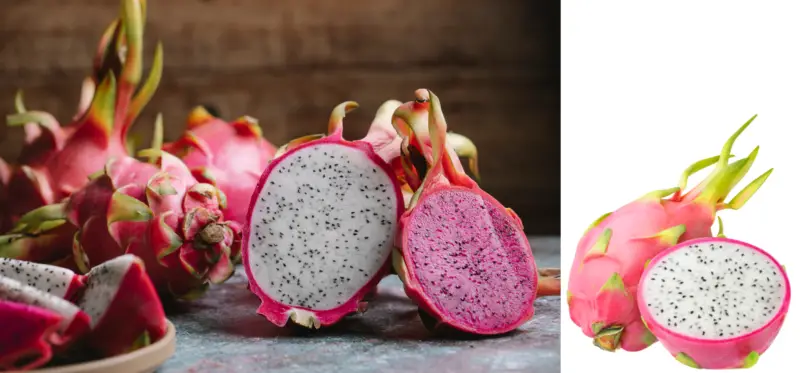
Dragon fruit is generally considered to be safe for dogs. It is non-toxic and does not contain any harmful components that could pose a risk to your pet’s health. However, ensuring that the fruit is prepared correctly and in moderation is essential.
The fruit has numerous health benefits that can contribute to a dog’s well-being. It is low in cholesterol and rich in antioxidants, which help combat various ailments like obesity and diabetes. Additionally, dragon fruit is an excellent fiber source, promoting healthy digestion in dogs.
However, there are a few factors to be aware of when offering dragon fruit to your pug. As with any new food, it is essential to introduce the fruit gradually to monitor your pug’s reaction. Observe for any signs of allergic reactions or digestive issues, and if any occur, discontinue feeding dragon fruit immediately. Furthermore, it is advised to remove the skin and seeds from the fruit before feeding it to your pet, as these could pose choking hazards or cause digestive complications.
While dragon fruit is safe for pugs to consume, it is crucial to remember that it should not be a primary source of nutrition. A balanced diet is necessary for the pug’s overall health, and dragon fruit should only be offered as an occasional treat. It is always recommended to consult with a veterinarian before introducing any new food to your dog’s diet to ensure it is safe and appropriate for your pet’s specific needs.
In summary, when given in moderation and adequately prepared, dragon fruit is a safe, non-toxic, and healthy treat for pugs. It is essential to monitor your pug’s reaction to the fruit and consult a veterinarian for guidance in maintaining a balanced and nutritious diet for your furry companion.
Benefits of Dragon Fruit for Pugs

Dragon fruit is a tropical fruit that can offer some notable health benefits to pugs when consumed in moderate amounts. The fruit is packed with antioxidants and nutrients, which support various aspects of a pug’s health.
Feeding a pug dragon fruit can have a positive impact on its coat. The fruit is rich in lipids that help maintain a healthy skin and coat, keeping it shiny and soft. The antioxidants in dragon fruit may also promote better skin health by reducing inflammation.
Dragon fruit can also contribute to a stronger immune system in pugs. The fruit contains vitamins and minerals, such as vitamin C and antioxidants, which help enhance the immune system and protect dogs from common health issues.
Another benefit of dragon fruit is its effect on a pug’s heart health. The low-fat content in this fruit can help reduce toxins, contributing to the overall well-being of your canine friend. Moreover, the fiber content of dragon fruit aids digestion, ensuring that your pug gets the most nutrients from their food.
Including dragon fruit in a pug’s diet can also support their bones. The fruit is a good source of calcium and magnesium, essential minerals for maintaining strong bones and preventing age-related bone diseases.
Lastly, dragon fruit’s rich antioxidant content can help combat aging in pugs. Antioxidants fight against free radicals, which can damage cells and contribute to aging. Incorporating dragon fruit into your pug’s diet and other nutrient-rich foods can help support their overall health and improve their quality of life as they age.
Potential Health Issues
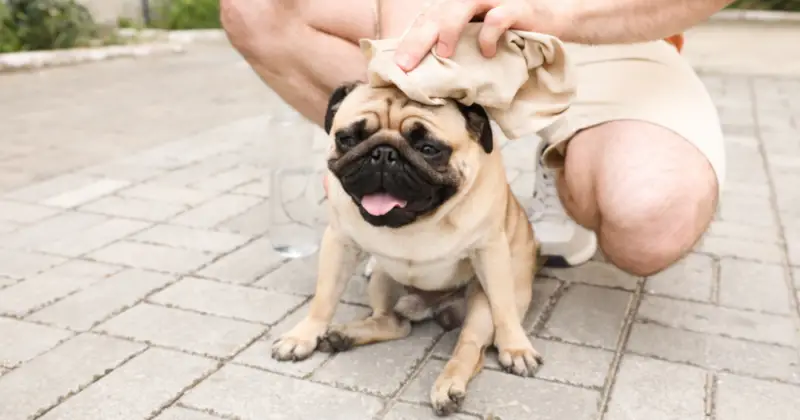
Dragon fruit is generally safe for pugs to consume, but there are some potential health issues that may arise if it is eaten in excessive amounts. One concern is the fruit’s high sugar content, which can lead to digestive issues such as diarrhea and vomiting. Limiting the amount of dragon fruit given to your pug is important to prevent these issues.
In addition to digestive problems, excessive sugar intake from dragon fruit can contribute to obesity and diabetes. Obesity is a common issue for pugs, as they are prone to gaining weight. Being overweight or obese can lead to other health problems, so monitoring your pug’s diet and ensuring it maintains a healthy weight is essential.
Another concern related to dragon fruit is its high fiber content. Though fiber can be beneficial for digestion, consuming too much can also cause gastrointestinal discomfort, such as gas, bloating, and, as mentioned earlier, diarrhea. Ensure to introduce dragon fruit to your pug slowly and in small amounts to avoid overloading their digestive system with fiber.
Although rare, there have been cases where the skin of the dragon fruit has caused skin irritation in some dogs, especially those with sensitive skin. To prevent this potential issue, make sure to remove the skin and only share the juicy flesh with your pug.
It is important to remember that while dragon fruit is not toxic to dogs, it should not make up a significant portion of their diet. Feeding your pug a balanced and complete diet is crucial to ensure they remain healthy and avoid long-term issues. While there is no direct correlation between dragon fruit consumption and cancer, a balanced diet rich in antioxidants, vitamins, and minerals can contribute to overall health and decrease the risk of developing certain types of cancer.
In conclusion, providing your pug with small amounts of dragon fruit can be a safe and enjoyable treat, but it’s important to be aware of the potential health issues that may arise if consumed in excess. Always monitor your pug’s overall diet and consult with your veterinarian if you have any concerns about introducing new foods.
Preparation and Serving Suggestions
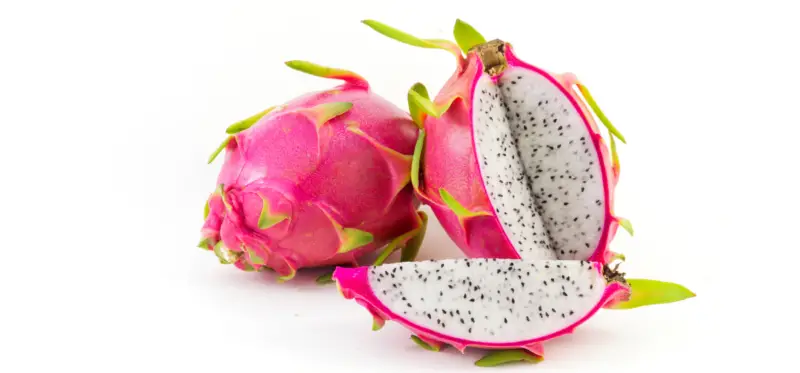
Dragon fruit can be a healthy addition to your pug’s diet, offering a variety of nutrients and antioxidants. To ensure your pug enjoys the fruit safely, follow these simple preparation steps:
First, wash the fruit thoroughly under running water to remove any dirt or contaminants that might be present on the skin. Next, slice the dragon fruit in half and use a spoon to scoop out the flesh, discarding the inedible peel. It’s best to serve dragon fruit in smaller pieces, as providing large chunks may be difficult for your pug to chew and swallow.
While dragon fruit seeds are safe for pugs to consume, you can remove them if you prefer, using a sieve or seed extractor to separate the seeds from the flesh. However, some dogs may enjoy the added texture and crunch of the seeds. Once the seeds are removed (or left intact, depending on your preference), you can further slice the fruit into smaller, bite-sized pieces.
If you have access to dried dragon fruit, it can be an alternative way to serve the fruit to your pug. However, be aware that drying may concentrate sugars and nutrients, so be cautious with portion sizes to avoid overfeeding and potential digestive issues.
Remember that moderation is essential when introducing any new food to your dog’s diet. Offer a small amount of dragon fruit initially and watch for any adverse reactions or digestive disturbances. Gradually increase the portion size over time as your pug becomes more accustomed to the fruit.
In summary, to serve dragon fruit to your pug, clean it well, remove the peel, slice the flesh into small pieces, and decide whether to keep or remove the seeds. Always exercise in moderation and monitor your dog’s response when introducing new foods to their diet.
Can Pugs Eat Dragon Fruit? Watch this:
Other Fruits Safe for Pugs
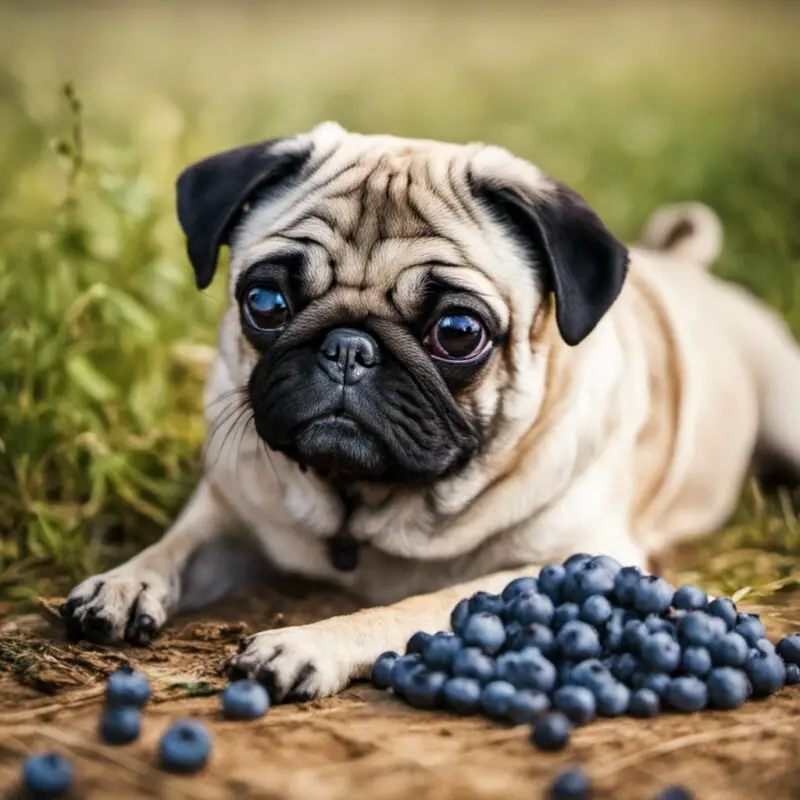
Pugs can enjoy a variety of fruits as occasional treats in their diet. Apples, for instance, are a great option since they contain vitamins A & C and are a good source of fiber. However, you should avoid feeding your Pug the seeds as they contain traces of cyanide1.
Berries like blueberries and blackberries are also safe for Pugs to consume. These fruits are low in calories and sugar but high in vitamins, minerals, and antioxidants2. Bananas can also be given to Pugs but should be given in moderation due to their sugar content.
Mangoes, pears, and cantaloupe are other fruits that can be safely included in your Pug’s diet. Cantaloupe is particularly beneficial as it is low in calories and has high water content, keeping your Pug hydrated and revitalized without causing weight gain3. However, always remember to remove the seeds and skin before offering these fruits to your Pug.
Watermelons are another excellent option for Pugs, providing hydration and nutrients. Make sure to remove the seeds and avoid feeding the rind, as it could cause gastrointestinal distress.
Oranges can be given to Pugs in moderation, as they are high in vitamin C but also contain a significant amount of sugar. It’s important always to remove the seeds and peel before offering a small slice to your Pug.
In conclusion, various fruits are safe for Pugs to enjoy in moderation. Offering these fruits as occasional treats can provide essential nutrients and variety in your Pug’s diet. Always remember to avoid feeding any seeds, skin, or rinds, and watch your pug’s weight and overall health to ensure these treats are beneficial.
Fruits to Avoid for Pugs

When it comes to feeding your pug fruits, there are a few that you should avoid for their health and safety. One such fruit is the avocado. It contains a toxin called persin which can cause vomiting and diarrhea in dogs source.
Cherries are another fruit to avoid, as they contain seeds and pits that can be a choking hazard for pugs. Moreover, the cherry seeds also contain cyanide, which is poisonous for dogs source.
It is important to keep your pug away from grapes as well. Grapes and raisins have been known to cause kidney failure in dogs, so it is best to prevent your pug from consuming their source.
Lastly, avoid feeding your pug peaches with pits, as the pits can cause blockages in the digestive tract. Peach pits also have cyanide traces that can harm your pug source.
By being aware of these potentially dangerous fruits, you can make informed decisions about which fruits are safe for your pug to consume. Remember, it is always best to consult with your veterinarian if you are unsure about a specific fruit or any other food for your pug.
Moderation is Key

When it comes to feeding your pug dragon fruit, moderation is essential. Dragon fruit is generally safe for dogs, including pugs, as long as it is given in moderation source. Packed with antioxidants and prebiotics, it can be a healthy treat for your pug. However, certain factors must be considered before letting your pug enjoy this snack.
Dragon fruits are known for their relatively high sugar content, containing approximately 5 grams of sugar per 100 grams source. While it’s not harmful in small amounts, excessive sugar intake might lead to obesity and diabetes in dogs. It’s vital to keep an eye on the amount of dragon fruit your pug consumes to prevent health issues due to its high sugar content.
In addition to sugar, it’s important to consider the calorie content of dragon fruit. Too many calories can lead to weight gain and affect your pug’s overall health. Providing your pug with a well-balanced diet will help ensure they receive the necessary nutrients and maintain an ideal weight.
Furthermore, dragon fruit can be a source of natural fats, which should also be given in moderation to your pug. Monitoring your pug’s fat intake is crucial, as excessive fat consumption might contribute to obesity and related health issues.
In conclusion, while dragon fruit can be a delicious and nutritious treat for your pug, it’s essential to remember that moderation is key. Limit their intake of this exotic fruit to ensure they maintain a healthy and balanced diet.
Consulting Your Veterinarian

It is always wise to consult with your veterinarian before introducing any new human food into your pug’s diet. This is particularly important when it comes to exotic fruits like dragon fruit. Although dragon fruit is generally considered safe and non-toxic for dogs, it’s essential to consider your pet’s unique dietary needs, allergies, and sensitivities.
Your veterinarian can evaluate your pug’s overall health and digestive system, recommending the best feeding practices for dragon fruit. The fruit may be suitable for moderate consumption given its high antioxidant and prebiotic properties. Still, it is essential to ensure your pug does not have underlying conditions that could be aggravated by it, such as kidney issues or a delicate digestive system.
Moreover, dogs with kidney problems, especially those at risk for kidney failure, should be assessed by a veterinarian before introducing them to any unfamiliar food. Kidneys play a critical role in filtering waste and toxins from the bloodstream, so it is essential to consider any potential impact that new foods might have on their proper functioning.
It’s important to remember that dogs are different, and their dietary needs may vary. A veterinarian can help create a personalized diet plan for your pug, taking into account your pet’s age, size, activity level, and any specific health concerns. By keeping your veterinarian involved in your pug’s diet, you can ensure they receive the proper nutrition and enjoy a happy, healthy life.
FAQs: Can Pugs Eat Dragon Fruit

Is dragon fruit safe for pugs to consume?
Yes, dragon fruit is safe for pugs to consume. It is non-toxic for dogs and provides some nutritional benefits. Always be sure to introduce new foods gradually and monitor your pug for any adverse reactions.
What are the potential benefits of dragon fruit for pugs?
Dragon fruit is rich in antioxidants and lipids, which can be beneficial for the skin and coat of pugs. It is also low in calories and can help with digestion when given in moderation.
Are there any risks associated with feeding pugs dragon fruit?
There are no significant risks associated with feeding pugs dragon fruit, but always be cautious when introducing new foods to your pet. Some pugs may have individual sensitivities or allergies, so observe your pug carefully for any signs of discomfort or adverse reactions.
How should dragon fruit be prepared for pugs?
To prepare dragon fruit for pugs, follow these steps:
Check if the fruit is ripe before cutting.
Wash the fruit in warm water to remove dirt.
Cut the fruit into two halves.
Scoop the flesh or peel the skin, then chop it into small cubes or slices for easy consumption.
Can pugs eat other similar exotic fruits?
Some exotic fruits are safe for pugs, like papaya and mango. However, it’s essential to research each fruit to ensure they are non-toxic and beneficial for your pug. Avoid fruits that contain seeds or pits that could be harmful, and always introduce new foods gradually.
Is there a specific amount of dragon fruit to feed pugs safely?
There is no specific amount of dragon fruit recommended for pugs, as each pug’s dietary needs may vary. It’s essential to feed dragon fruit in moderation and as an occasional treat rather than a staple in their diet. If you’re unsure, consult with your veterinarian to determine the appropriate serving size for your pug.



